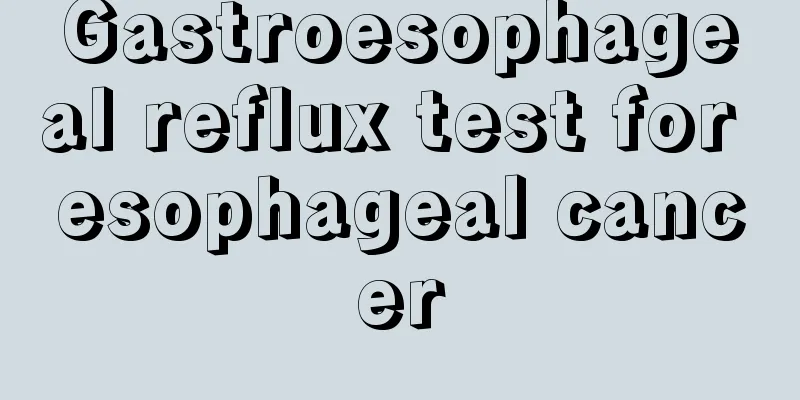Gastroesophageal reflux test for esophageal cancer

|
There are many reasons for gastroesophageal reflux in patients with esophageal cancer, such as mechanical defects of the cardia, poor propulsion of the esophageal body, gastric atony, pyloric dysfunction, delayed gastric emptying, and after esophageal cancer surgery. The reflux of gastric contents (especially gastric acid) into the esophagus causes the esophageal mucosa to contact with gastric contents for a long time, causing damage to the esophageal mucosa. Patients often have symptoms such as heartburn, vomiting, and pain behind the sternum. The following tests are helpful for the determination of gastroesophageal reflux. ① Esophageal acid perfusion test: The tester sits down and alternately perfuses normal saline and 0.1 mol/L hydrochloric acid into the middle of the esophagus at a rate of 6 ml per minute to measure the sensitivity of the esophagus to acid. When the acid is perfused, the patient experiences symptoms such as heartburn, chest pain, cough, and vomiting, and the symptoms disappear after the normal saline is perfused, which is a positive test. If no symptoms occur after 30 ml of acid is perfused, the test is negative. ②24h esophageal pH monitoring: Place the pH electrode above the high-pressure belt in the lower esophagus and continuously monitor the pH for 24 hours to observe the reflux of the subject under daily conditions. When the pH drops below 4, it is considered a reflux, and when the pH rises above 7, it is an alkaline reflux. By recording the patient's condition in various body positions and when eating, it is possible to diagnose whether the patient has reflux, the frequency of reflux, and the time it takes for the esophagus to clear the reflux. ③Lower esophageal sphincter manometry test The lower esophageal sphincter plays a role in ensuring the unidirectional transport of food in the physiological activities of the digestive tract, that is, the role of anti-gastroesophageal reflux. The function of the lower esophageal sphincter depends not only on its basic pressure at rest, but also on the influence of chest and abdominal pressure and its response to different physiological factors such as gastric expansion, swallowing, and changes in body position. Another factor that determines the function of the lower esophageal sphincter is its length in the abdomen. A catheter with a transducer can be inserted through the nostril to this site for measurement. |
<<: Pathological types of mid- to late-stage esophageal cancer
>>: X-ray barium meal examination of esophageal cancer
Recommend
Experts briefly analyze the common types of lung cancer
The classification of lung cancer is a matter of ...
Black loose stools are a detoxification method
Both human defecation and urination are related t...
Treatment of anorectal canal inflammation
Many people around us have suffered from proctoan...
How to enhance immunity
Immunity is really important for a person. If a p...
Autumnal urticaria
Autumnal urticaria? As the weather continues to w...
What are the symptoms of tongue cancer
What are the symptoms of tongue cancer? When it c...
What is the nutritional value of eel blood
I believe everyone has eaten it. I don’t need to ...
What is the reason for my nose
Rosacea is what we usually call the red nose phen...
Can people with high blood pressure eat abalone?
Abalone and shark fin are both relatively high-en...
Chronic gastritis level 2
Many people nowadays have disordered lifestyles, ...
Characteristics of gastric cancer patients sleeping at night
The characteristics of gastric cancer at night in...
Diet after endometrial cancer removal
Endometrial cancer is listed as one of the three ...
How long is the shelf life of perfume
Most female friends who love beauty use perfume. ...
What are the preferred hospitals for esophageal cancer
The relevant selection criteria of esophageal can...
Six unexpected causes of insomnia
If you don’t drink coffee or tea before going to ...









